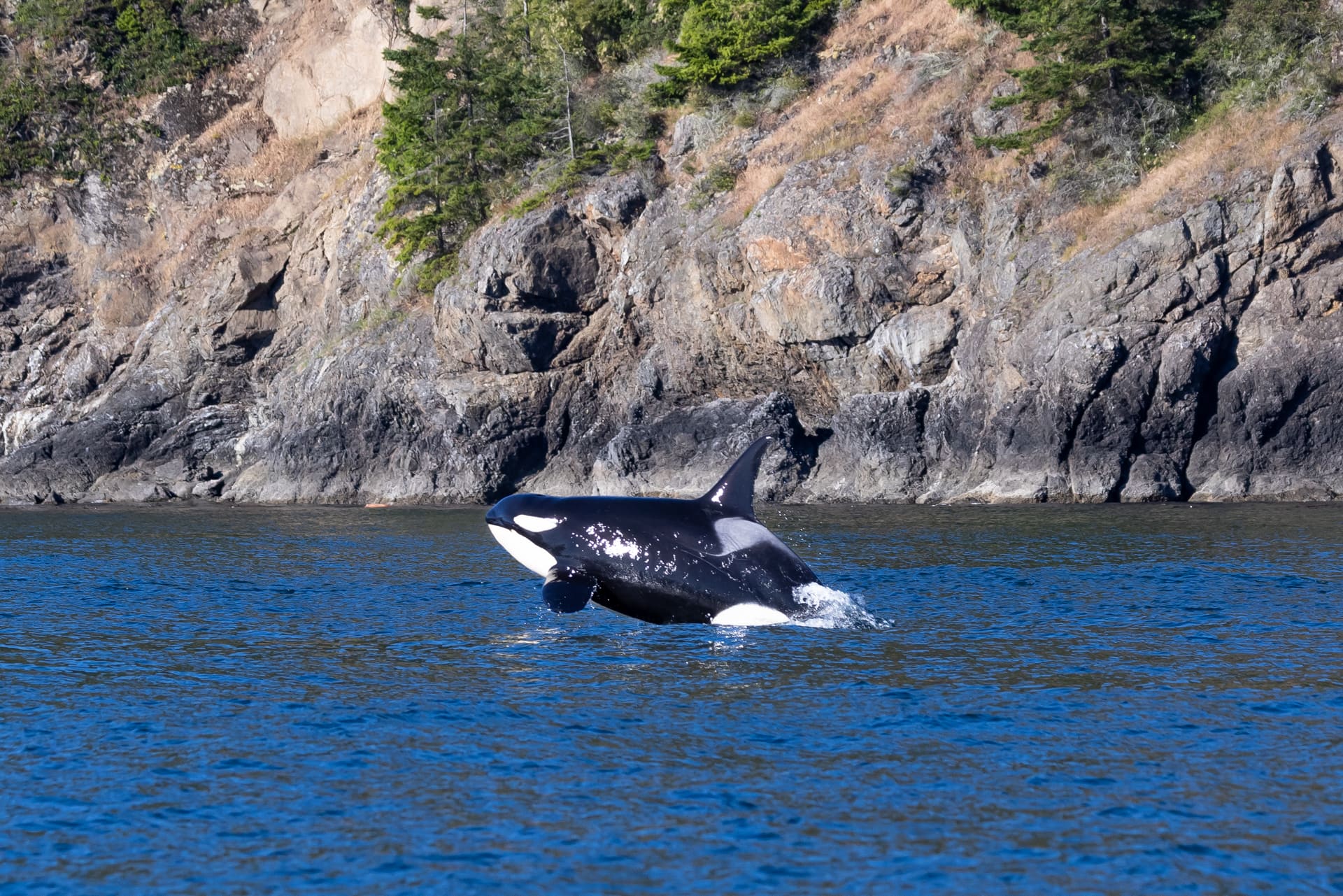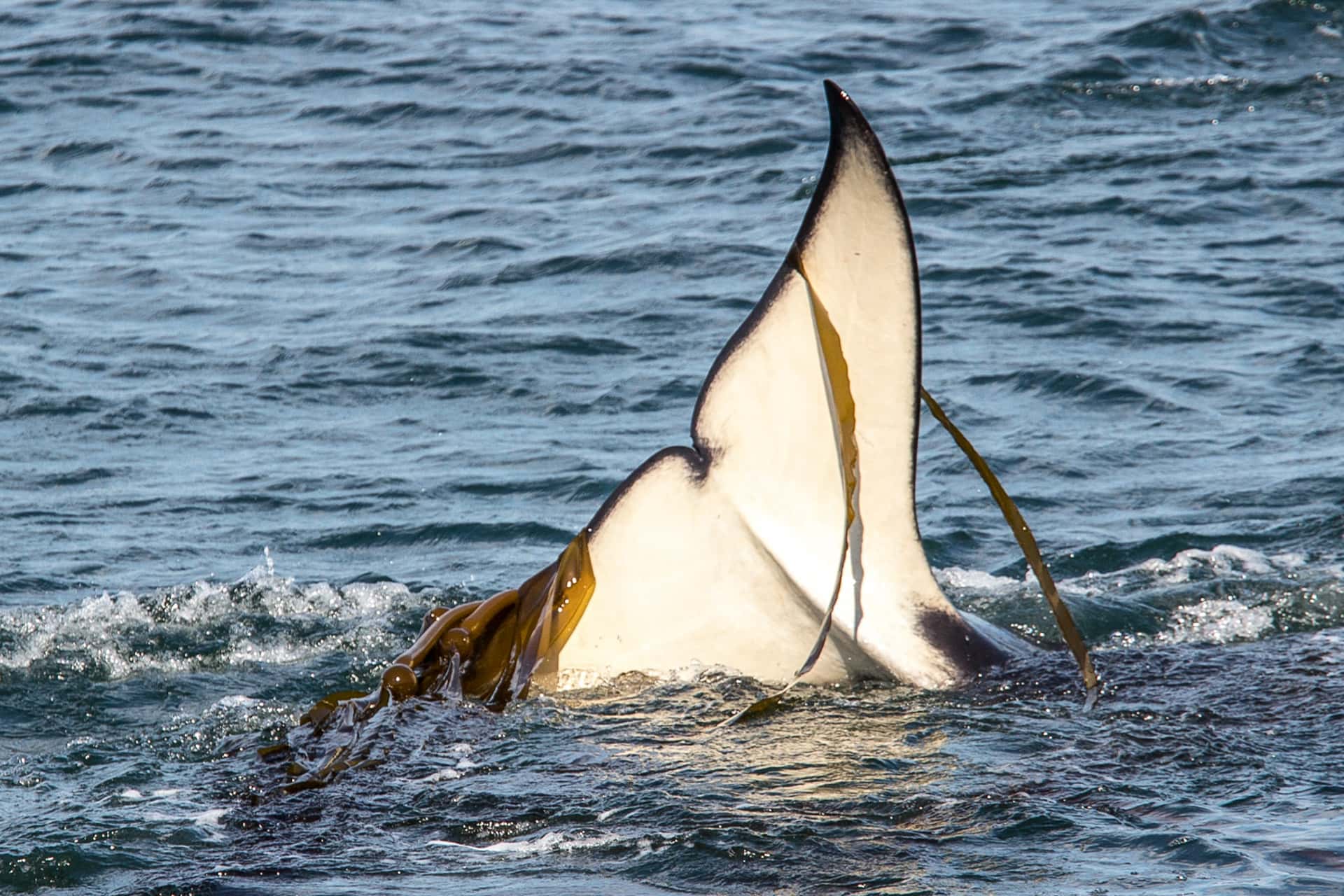
The main driver behind the population decline of the endangered Southern Resident killer whales is ongoing seasonal shortages of their prey of choice—Chinook salmon. Research shows that vessel noise likely makes it harder for them to find this prey and hunt successfully. A 2021 government research study sought to understand better the whales’ behavior in the presence of boats and whether noise interrupts prey hunting. If so, what measures could better protect them?
What was the study?
Unlike previous land-based observations, this study dove into the whales’ world. Researchers attached temporary suction-cup tags to an identified Southern Resident killer whale. Over three study years—each September in the Salish Sea—13 tags were successfully deployed on seven females and six males, recording 3609 unique dives. These technology-rich digital tags recorded the whales’ direction and speed when diving or traveling, while rapid changes in acceleration indicated prey hunting behavior.
The tags also recorded the sounds generated to find and capture prey. Similar to submarine sonar technology, echolocation clicks produce sound waves that bounce off objects in their path. The returning signal indicates species, size, and the distance of predator from prey. Researchers were able to distinguish between the function of different echolocation sounds. Slow clicks indicate scanning the surrounding area; faster clicks indicate pursuit, and rapid clicks—heard as buzzing—occur right before the catch.
While the tags hitched a ride, researchers recorded data such as the number of vessels within a mile, and their proximity, speed, and direction relative to the tagged whale. Researchers overlayed their on-the-water observations with the tags’ underwater observations to understand how the whales’ behavior changed in the close presence of vessels.

NOAA Fisheries researchers apply temporary suction cup tags to record sound levels experienced by Southern Resident killer whales.
What did the tags show?
From the tags’ recordings of sound and movement, researchers defined four distinct “whale states”:
- Traveling, including shallow respiratory dives.
- Deep dives with rapid changes in acceleration indicated the pursuit of prey. Clicks and buzzing indicated close pursuit, with attempted and successful prey capture, with prey-sharing events.
- Shallow dives, with echolocation clicks, indicated scanning for prey.
- Shallow and intermediate dives, some clicking, almost no buzzing, suggest prey search but not close pursuit or capture, with possible prey sharing or socializing.
By analyzing how frequently an animal moved between these different states, researchers could assess changes in the whales’ behavior, such as interrupting prey hunting, and whether that could be related to vessel distance.
What did the results show? Vessel distance made a difference.
Researchers observed a noticeable difference in the Southern Resident killer whales’ behavior when vessels were within 400 yards, defined as “close” for the purposes of this study. Specifically, “the whales made fewer prey capture dives and spent less time in such dives when vessels were close.” In fact, males and females spent substantially less time in deeper dives—where successful foraging occurs—when vessels were within 400 yards.
Particularly striking was the effect on females, who “switched to a state distinctly different from foraging when vessels were close compared to when vessels were far.” Researchers suggested that females may significantly interrupt their prey hunting when vessels are close when caring for young animals or while pregnant. This is a massive cause for concern, particularly given the low birth and high pregnancy failure rates.
In conclusion, researchers found that close vessels—within 400 yards—did interrupt prey hunting. They suggested that regulations to increase vessel distance could increase the whales’ success as “deep foraging opportunities can be enhanced when vessels give whales, especially females, more space.” Researchers noted that their findings should inform future management decisions to “preserve foraging opportunities.”
Continued below...
In 2019, after this research ended, Washington State introduced new regulations for commercial whale-watching vessels and increased the buffer zone around the Southern Resident killer whales to 1000 yards. New legislation proposed in 2022 would expand these regulations to include recreational boaters and kayakers.
While these new proposed changes are welcome and may help increase the whales’ foraging success, the most obvious solution is to limit fishing and increase the number of fish available for the whales to catch. Regulation enforcement must also be addressed, as current enforcement measures aren’t adequate.
Yet, in a recent U-turn, the government changed the backstop that would have applied fishing restrictions in years of low Chinook abundance. No doubt this will raise another legal challenge, but how many more fishing seasons do endangered Chinook salmon, and killer whales have left?





